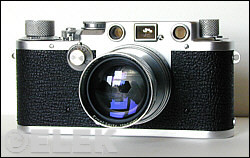Leica IIIf

|
|
|
| Style, film format | 35mm rangefinder system with interchangeable lenses |
|
|
|
| Lens, shutter | Collapsible 50mm f/2.0 Summitar, horizontal cloth |
|
|
|
| Photo quality | Excellent |
|
|
|
| Ergonomics | If only Leitz had unified the rangefinder and viewfinder; slow-speed dial is baffling for the novice |
|
|
|
So the question that immediately popped into my head was: "Do I need a Leica?"
Does anybody need a Leica? If you're a classic camera person and photographer in earnest, the answer is an immediate yes. The Leica brand inspires more passion and near hatred than nearly any other marque of camera. It probably even overtakes the Canon vs. Nikon debate.
I wasn't really sure what to expect for my hard-earned cash, but after using the Leica for a couple of week's straight, I can honestly say that this camera deserves its many accolades.
It's a wonderfully small size. The body is extremely solid because of its unusual construction. For those not familiar with Leica rangefinders, there is no camera back. The body is one piece. Think of a flattened tube, and you get the idea.
Loading the film took me two times to understand it. After that, no problem, although cutting a four-inch leader in the field should be interesting.
The controls operate with a fine precision that you just don't see any more. Film advance is smooth without any of the grittiness that you often get with other cameras. The shutter release is silky smooth, and the camera's quality craftsmanship really comes through every time you touch it.
Any gripes? Well, there are the two windows: separate viewfinder and rangefinder. They aren't difficult to use, but it is a bit frustrating shifting your eye from one window to the other. The Summitar intrudes into the viewfinder. You lose about 1/6 of the lower right part of the frame.
This camera was made in 1951 or 1952. You know, Zeiss Ikon managed to combine their rangefinder/viewfinder in 1936. You would think that Leitz could have figured that out before the 1950s. Well, they did with the M series in the 1950s, but it shouldn't have taken Leitz nearly three decades.
And I don't see any reason that the shutter speed dial should spin when you press the shutter release. It's just not necessary. Same goes with the separate dial for the slow speeds. Why, why, why?
Regardless, it's the final product that counts, and I really like the photos from this camera. They have a very interesting look to them -- different from the cookie-cutter look of today's highly refined SLR glass.
I highly recommend you try a Leica once in your life.
